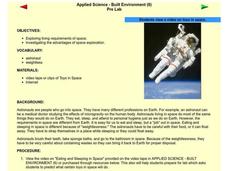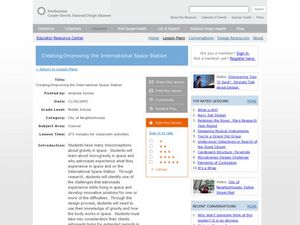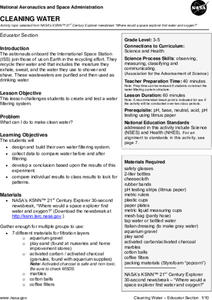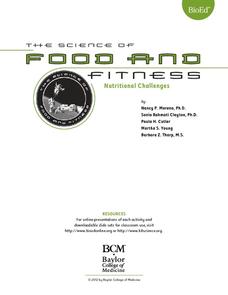Curated OER
Reading: Living in Space
In this living in space reading worksheet, students read a passage about life on the International Space Station written by a former astronaut. Students then answer 6 multiple choice questions.
Curated OER
The Sun, Moon, and Our Solar System: Teacher/Student Notes
Introduce basic Earth and space science to your budding astronauts. This handout works in two ways, the first part provides information about the sun, moon, eclipses, and Earth to be read to or by the class. The second part is composed...
NASA
Cleaning Water
From their sweat to the water vapor in their breath, astronauts recycle every possible drop of water while in space. After watching a short video describing the different ways materials are recycled and reused in space shuttles, young...
Curated OER
Space Flight Simulation
High schoolers engage in the study of flight with the help of a computer flight simulation. They take part in a variety of activities that imitate the Space Shuttle Endeavor. Students work as teams like the astronauts would to complete...
Curated OER
Living in Space
Students explore space science by viewing a video in class. In this astronaut lesson, students identify the living habits of astronauts by researching the NASA website and observing a space science video in class. Students participate in...
Messenger Education
Mission: Possible—How Can We Plan an Exploration of Another World?
An astronaut's spacesuit weighs 280 pounds and takes 45 minutes to put on — that's a serious suit! The second activity of a three-part series allows pupils to see all that goes into space exploration. Through simulations, groups analyze...
University of Colorado
Planetary Distances on the Playground
Earth is 149,600,000 km, or 92,957,130.4 miles, from the sun. Young astronauts create an interactive model to learn the distances between planets. Nine groups, each representing a different planet, are spread around at class-calculated...
Curated OER
Fighting Back!
Fifth graders inspect the basic functions of the immune system and determine how viruses and bacteria invade the immune system. They also explore what happens to the immune system in outer space.
Curated OER
TE Lesson: Out of Breath
Students study the parts of the human respiratory system while examining the gas exchange that takes place in the lungs. They make a model lung. They look at how the respiratory system is affected by spaceflight.
Curated OER
Creating/Improving the International Space Station
Middle schoolers research space and gravity and understand the difficulties humans have while on the International Space Station. In this space lesson plan, students listen to personal accounts of astronauts on videos and present designs...
NASA
Cleaning Water
Give young scientists a new appreciation of fresh, clean drinking water. After learning about the ways astronauts recycle their air and water, your class will work in small groups creating and testing their very own water filtration...
NASA
Spacewalking
Hold your breath. The video and interactive website introduce the class to spacewalking and spacesuits. Using oxygen data from two astronauts, individuals determine a mathematical model to fit the data. Using that mathematical model, the...
NASA
Suit Yourself: Fitted for Space
If he keeps this up, will he have enough air? After watching a video about spacewalks, groups of four brainstorm aspects of spacesuit design and present it to the rest of the class. Groups create mathematical models of oxygen use for two...
BioEd Online
Good Stress for Your Body
Stress the importance of the different types of pressure our mind and body experience in a lesson about how certain types of stress are actually necessary and good for our bodies. As astronauts and people with injuries can attest, not...
BioEd Online
Muscle Fibers
What better way to learn about muscle than by dissecting one? Using cow muscle (beef), learners compare bundles of yarn to muscle fibers as they explore each. The supplemental reading about astronauts losing muscle mass in space and what...
BioEd Online
Butterflies in Space
How does gravity affect the life cycle of a butterfly? Learn first-hand what types of investigations astronauts perform in space by following along with one of NASA's experiments. Create butterfly habitats in the classroom with specific...
NASA
Lost in Space: Bone Density
If you don't use it, you lose it. Groups work together to compare bone loss on Earth as opposed to bone loss in space. They determine the equations that model bone loss and make calculations to determine the amount of bone loss for...
NASA
Lunar Plant Growth Chamber
Would astronauts be able to grow their food on the Moon? Teams research plant growth in order to design and build a growth chamber that will function on the lunar surface. They narrow down plant choices based upon their strengths and...
BioEd Online
Nutritional Challenges
Eating healthy can be a challenge, especially for people with special dietary needs. After learning about standard nutritional needs for adults, learners take on the role of a dietician and work together to create a menu for one of the...
NASA
Exercising in Space
Using the CEVIS space bike as a context, groups work together to calculate the settings required for astronauts to reach their necessary exercise. Pupils calculate the prescribed exercise settings and complete the last section, which can...
NASA
Communications and the Lunar Outpost
Can you hear me now? Groups use given information about communication on the moon to determine the maximum distance an astronaut can travel and stay in communication. Using the calculations, they determine what lunar features they can...
NASA
Oh, Chute!
Using a scare model of the a test vehicle developed by the Systems Architecture and Integration Office at NASA, groups determine the dimensions for a scale model of the parachute compartment. The groups also determine the volume of the...
Curated OER
The Universe
Fifth graders identify and discuss responsibilities of careers related to the study of the universe, such as an astronomer or an astronaut. They compare what the world looks like now to what it might look like in the year 3000.
Curated OER
Worksheet 7. Food Categories
In this nutrition worksheet, students analyze 2 typical menus for astronauts. They then complete the food chart at the bottom of the page using the components of the astronaut menus.

























